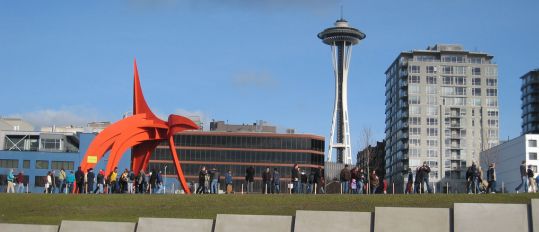“Cities are what’s going to get us out of this mess … and what makes cities livable is art.”
That was the take-home message, summarized by Cascade Land Conservancy President Gene Duvernoy, following a discussion Thursday on art and the environment at the Seattle Art Museum’s Olympic Sculpture Park.
Built on nine acres of restored urban green space, the Olympic Sculpture Park was a fitting backdrop for a dialogue on shared interests between the arts community and environmentalists. Panelists including moderator and political journalist Michael Kinsley, Pacific Northwest Ballet Artistic Director Peter Boal, University of Washington College of Architecture Dean Daniel Friedman, arts and environment advocate Maggie Walker, and Northwest artist trio SuttonBeresCuller spoke about the importance of creating green space and building vibrant urban communities.
The discussion opened with Kinsley attempting to engage the panelists in a debate about how art and the environment are in fundamental conflict — because, he explained, environmentalists want to leave the landscape as-is, while the purpose of art is to use creativity to transform that landscape — but no one took the bait.
Instead, Walker challenged the idea that environmentalism must be anti-human, saying, “if we are really going to embrace a full sense of our place in nature … we need to have great cities, we need to have great wooded lands, we need to have great farmlands, we need to have great buildings, and we need to steward it all.”
Civic partnerships between artists, organizations, and individual citizens can play an important role in that, the SuttonBeresCuller trio added. “Art can act like a catalyst; it opens up new ways of approaching the use of space and the use of technology. And the audience cross-pollinates: artists working with environmental issues, environmental organizations or companies manufacturing those goods are working with the artists.”
A perfect example of marrying the two comes in the form of SuttonBeresCuller’s latest project, the Mini-Mart City Park, which will turn an abandoned gas station into a green space and art installation. And certainly the Olympic Sculpture Park itself, with its history as a toxic dump, is another great reincarnation story.
As the panel moved to a Q&A with the audience, Friedman praised the discussion for “really centraliz[ing] the importance that art has in helping us experience … our own world.”
And Walker, when asked how to make environmental stewardship less of an abstract idea, emphasized the value of the art community’s involvement in the issue: “I love the fact that artists are starting to tackle this — it’s really important that they are examining this, making it accessible, and making us all aware of what the issues are.”
With Kinsley’s argument defeated, the panel discussion closed with parting thoughts about engaging both the arts and environmental communities in creating vibrant, livable cities. And the audience filed out the glass doors of the pavilion onto a reclaimed wasteland brought to life with beautiful works of art — both natural and man-made.


